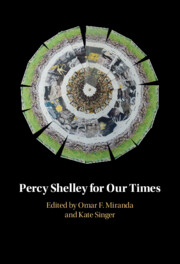Book contents
- Percy Shelley for Our Times
- Reviews
- Percy Shelley for Our Times
- Copyright page
- Contents
- Notes on Contributors
- Acknowledgments
- Abbreviations
- Introduction
- 1 Shelley, Treaty-Making, and Indigenous Poetry
- 2 Waiting for the Revolution
- 3 “A Chamæleonic Race”
- 4 Dream Defenders and the Inside Songs
- 5 Radical Suffering
- 6 Loathsome Sympathy
- 7 Hopeless Romanticism
- 8 Percy Shelley’s Sad Exile
- 9 Shelley in the Overgrowth
- 10 Creatrix Witches, Nonbinary Creatures, and Shelleyan Transmedia
- 11 Action at a Distance
- 12 Educating the Imagination/Defending Shelley Defending
- Further Reading
- Index
11 - Action at a Distance
Communication and Material Entanglement in Queen Mab and The Mask of Anarchy
Published online by Cambridge University Press: 07 March 2024
- Percy Shelley for Our Times
- Reviews
- Percy Shelley for Our Times
- Copyright page
- Contents
- Notes on Contributors
- Acknowledgments
- Abbreviations
- Introduction
- 1 Shelley, Treaty-Making, and Indigenous Poetry
- 2 Waiting for the Revolution
- 3 “A Chamæleonic Race”
- 4 Dream Defenders and the Inside Songs
- 5 Radical Suffering
- 6 Loathsome Sympathy
- 7 Hopeless Romanticism
- 8 Percy Shelley’s Sad Exile
- 9 Shelley in the Overgrowth
- 10 Creatrix Witches, Nonbinary Creatures, and Shelleyan Transmedia
- 11 Action at a Distance
- 12 Educating the Imagination/Defending Shelley Defending
- Further Reading
- Index
Summary
This chapter investigates Shelley’s fascination with issues of communication, especially his engagement with concepts of action at a distance, “the action of one object on another regardless of the presence or absence of an intervening medium” (Oxford English Dictionary). Shelley’s attempts to overcome distances of space and time were a feature of his correspondence, especially during his years in Italy. Action at a distance also informs his representation of a materialized physical universe in early works like Queen Mab (1813) and provides a foundation for his later accounts of political communication in The Mask of Anarchy (1819). I suggest that Shelley’s account of unmediated action at a distance coalesces with more recent treatments of matter and mediation in quantum physics and especially in Karen Barad’s account of material entanglements in which “matter [is] a dynamic and shifting entanglement of relations, rather than a property of things.” Shelley’s poetry itself functions as a form of Baradian apparatus with the facility to offer “agential cuts,” providing moments of insight within intra-active material systems. In these poems, Shelley presents the universe as one continuous material system, which enables unmediated communication across any distance, and which at times of political crisis enables instantaneous solidarity and resistance.
- Type
- Chapter
- Information
- Percy Shelley for Our Times , pp. 238 - 259Publisher: Cambridge University PressPrint publication year: 2024



